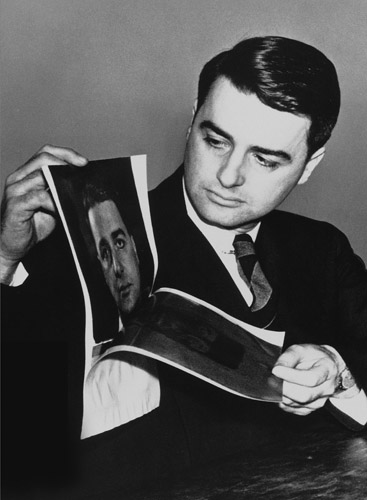Edwin H. Land
Edwin H. Land

OSA Honorary Member Edwin Land was born 7 May 1909 in Bridgeport, Connecticut, USA. He attended the Norwich Free Academy in Conn., and graduated in 1927. During his first year at Harvard University he studied chemistry but soon left for New York City.
Despite not having a lab or degree, Land was able to invent the first inexpensive filters capable of polarizing light. His breakthrough came when he realized that instead of attempting to grow a large single crystal of a polarizing substance, he could manufacture a film with millions of micrometer-sized polarizing crystals that were coaxed into perfect alignment with each other.
After developing the polarizing film, Land returned to Harvard, but still did not finish his degree. In 1932, he established the Land-Wheelwright Laboratories with his Harvard physics instructor to commercialize his polarizing technology. After a few early successes developing polarizing filters for sunglasses and photographic filters, Land obtained funding from a series of Wall Street investors for further expansion. The company was renamed the Polaroid Corporation in 1937. Land further developed and produced sheet polarizers under the Polaroid trademark.
Although the initial major application was for sunglasses and scientific work, it quickly found many additional applications, including: color animation in the Wurlitzer 850 Peacock jukebox of 1942, glasses in full-color stereoscopic (3-D) movies, and to control brightness of light through a window. During World War II, Land worked on military tasks, which included developing dark-adaptation goggles, target finders, the first passively guided smart bombs, and a special stereoscopic viewing system called the Vectrograph which revealed camouflaged enemy positions in aerial photography.
In 1947 at OSA's Winter Meeting, Land demonstrated an instant camera and associated film. The Land Camera was commercially available two years later. Polaroid originally manufactured 60 units of this first camera. Fifty-seven were put up for sale at Boston's Jordan Marsh department store before the 1948 Christmas holiday, and all 57 sold out in the first day in stores. That same year, Land became one of OSA's first Traveling Lecturers.
In the 1950s, Land and his team helped design the optics of the revolutionary Lockheed U-2 spy plane. Also in this decade, Land first discovered a two-color system for projecting the entire spectrum of hues with only two colors of projecting light. Some of this work was later incorporated in his Retinex theory of color vision. In 1959, Land was elected an OSA Fellow.
In the early 1970s, Land attempted to explain the previously known phenomenon of color constancy with his Retinex theory. His popular demonstrations of color constancy raised much interest in the concept. He considered his leadership towards the development of integral instant color photography — the SX-70 film and camera —his crowning achievement.
Although Land held no formal degree, he received numerous honorary degrees, including ones from Harvard, Yale, and Columbia. He received the Presidential Medal of Freedom for his optics research, the OSA Ives Medal, and the Cresson, Potts and Vermilye Medals from the Franklin Institute. Land was inducted into the National Inventors Hall of Fame and received the National Medal of Technology. He held 535 U.S. patents.
In 1972, he was named an Honorary Member of the Optical Society in recognition of his preeminent service in the advancement of optics.
He resigned as chairman of Polaroid in 1980. In his retirement years, he founded the Rowland Institute for Science at Harvard University.
Land died in 1 March 1991.
In 1992, The Edwin H. Land Medal was established by The Optical Society (OSA) and the Society for Imaging Science and Technology (IS&T) to honor Edwin H. Land and to recognize his unique career as scientist, technologist, industrialist, humanist and public servant. This medal recognizes pioneering work empowered by scientific research to create inventions, technologies, and products. The recipient(s) should share Land's insatiable scientific intensity and curiosity in optics and imaging and, in part, reflect his image as inventor, scientist, entrepreneur, and teacher.
Industry is best at the intersection of science and art.
Document Created: 26 July 2023
Last Updated: 28 August 2023
